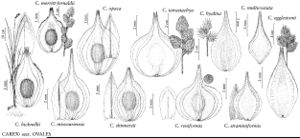Carex reniformis
Fl. S.E. U. S., 220, 1328. 1903.
Plants cespitose; rhizomes appearing elongate in old clumps, 1.5–5 mm wide, mostly 1 shoot per node. Culms 25–75 cm; vegetative culms few, inconspicuous, usually fewer than 12 leaves, not strikingly 3-ranked. Leaves: sheaths with adaxial hyaline band, summits U-shaped; distal ligules 1.7–3.6 mm; blades 4–5 per fertile culm, 10–25 cm × 1.8–3.2 mm. Inflorescences open, yellow-green, 2–5 cm × 6–14 mm; proximal internode 5–11 mm; 2d internode 5–13 mm; proximal bracts scalelike or with bristle tip shorter than or equaling inflorescences. Spikes 3–6, distant, distinct, ellipsoid to ovoid, 7–12 × 5–10 mm, base rounded to acute, apex rounded. Pistillate scales white-hyaline with green midstripe, ovate, 2–3.5 mm, reaching base of perignyium beaks, narrower than perigynia, apex obtuse to rounded. Perigynia 15–80 in larger spikes, ascending, straw colored, green distally, inconspicuously veined on each face, reniform to orbiculate, flat, 4–5.3 × 3.5–4.5(–4.9) mm, 0.4–0.6 mm thick, margin flat, including wing 1–1.5 mm wide, finely granular-papillose (30X); beak pale or green at tip, flat, ciliate-serrulate, abaxial suture with conspicuous white-hyaline margin, distance from beak tip to achene 2–2.7 mm. Achenes elliptic, 1.8–2.2 × 1.2–1.5 mm, 0.4–0.6 mm thick. 2n = 80.
Phenology: Fruiting late spring.
Habitat: Wet woods, bottomlands
Elevation: 0–300 m
Distribution

Ala., Ark., Fla., Ga., Ill., Ky., La., Miss., Mo., N.C., Okla., S.C., Tenn., Tex., Va.
Discussion
Selected References
None.
